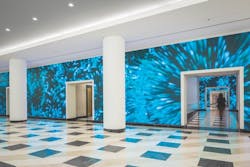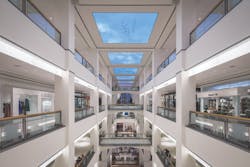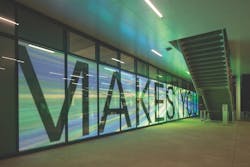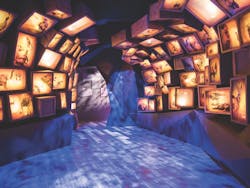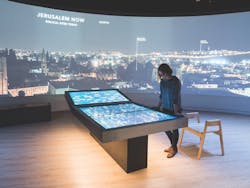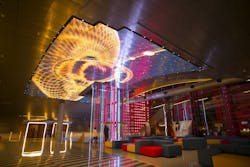Huge digital billboards that blare their messages from the sides of skyscrapers and along highways have become part of America’s urban landscape. And now, a growing number of developers are bringing a subtler—and, in many respects, more aesthetically indigenous—form of digital media inside their buildings to enliven or rebrand their properties, and to connect them closer to occupants, tenants, and neighborhoods.
Digital media “is where sustainability was a decade ago,” observes Steven Joswick, Senior Associate and Design Director in Gensler’s Washington, D.C., office. And he believes digital media has the potential for achieving the same arc toward industry acceptance.
“Sustainability is now a baseline, and we’re definitely seeing an uptick in interest [in interior digital media] among our clients. It’s beyond a fad,” says Joswick. “We’re reaching a point where if a building doesn’t include a digital component, you’re going to think it’s ‘broken.’”
Digital media can turn a building into “an experiential North Star,” says David Bianciardi, Principal and Founder of New York-based AV&C, which specializes in creating and installing digital software that Bianciardi says tells “stories,” and forges a union between the built environment and technology.
Digital media comes in all kinds of deliverables, including ultra-high-definition projection systems, art installations, interactive and responsive displays, and live content feeds. An early example is the Global Data Chandelier that since 2013 has adorned the atrium of the Washington, D.C., headquarters of the Center for Strategic and International Studies. The architectural and marketing firm Sosolimited partnered with Hypersonic Engineering & Design, Plebian Design, and designer Chris Parlato of Innovation Strategy to design, program, and fabricate this installation, which consists of 425 pendants that form a map of the world when viewed from below. As visitors walk up the stairs, the installation coordinates with a display of global data that ranges from GDP growth and annual rainfall to energy consumption and financial information. Each data set is paired with a unique lighting animation.
“This fits into the specialty of the think tank,” says Justin Manor, Soslimited’s Director of Innovation.
But digital media can be expensive. Sosolimited’s projects typically run six figures or higher. The IT budget alone for the new Museum of the Bible in Washington, D.C., with its rich digital mixture, was $42 million. And digital media demands an attention to content management and maintenance that goes beyond what most AEC firms and building owners/developers are used to or capable of providing. This explains why AEC firms often team with creative specialists and service providers with expertise in such areas as visual effects, lighting, and videography.
The return on investment for digital media isn’t always that easy to calculate, either. That might explain why experts in this field prefer the term “return on engagement,” which emphasizes how digital media, over time, enhances a building’s cachet and allure.
As technology evolves, designers and installers are exploring how sensors, virtual reality, artificial intelligence, and social media can help keep a building’s digital content fresh and relevant.
Getting the word out
ESI Design, a New York design firm that has created more than a dozen digital media installations in the U.S., recently completed a content update to integrate social media into a project it installed in 2013, at 221 Main Street, a 16-story Class A office tower in San Francisco. The installation is a 126-foot-long by 25-foot-wide digital display made from more than 100 pieces of high-intensity laminated glass (which meets seismic code), which runs along the ceiling of the building’s entrance canopy, and leads to a digital wall installation inside the lobby. It blends three different LED resolutions into a single display that flashes a rotation of moving images, such as ocean waves crashing across the lobby wall and the entire length of the canopy’s exterior façade.
The content upgrade, launched in March 2017, allows visitors to post Twitter feeds to a digital board at the front of the canopy, which recreates the feeds as a constant stream of keywords. “Digital media is helping the building create a sense of culture and experience,” says Greg Gallimore, ESI’s Director of Media Architecture.
Drawing power
Beacon Capital Partners was ESI’s original client for 221 Main Street, one of 34 Beacon properties in which ESI has installed digital media. (Columbia Property Trust, the building’s current owner, commissioned the content update.) Beacon declined BD+C’s request for comment, but there’s little doubt that developers view digital media as an energizing element of their branding and marketing strategies.
A few years back, the developer Solidere commissioned Los Angeles-based design studio StandardVision to design and integrate a video screen into a massive architectural dome inside CinemaCity, a 33,000-sf, 14-screen movie palace in Beirut, Lebanon. The video screen’s eye-popping resolution (6,480 x 3,840 pixels) was touted at the time as the sharpest in the world. StandardVision also installed more than 300 feet of hallway projections and art programming.
Digital media helped make CinemaCity a rousing success. A year after it opened, in 2013, ticket sales averaged 3,000 per day, the highest totals a new multiplex in that country had ever generated.
“Our goal is to create an emotional connection between the viewer, the architecture, and, where appropriate, the brand,” explains Kevin Bartanian, StandardVision’s Executive Vice President of Sales and Business Development. He tells BD+C that on every project, his firm considers four things: the experience being created, how it will attract tenants or customers to the property, how it drives attention to other parts of the building, and how it “fosters community” by using local artists’ or students’ work.
The 60,000-sf, three-level NatGeo Encounter: Ocean Odyssey exhibit in New York City uses photo-real computer graphics to let visitors feel as if they are walking through the Pacific Ocean. The extensive interaction throughout the exhibit includes “contact” with digital sea lions and coral reef. The journey ends inside an Exploration Hall with educational holograms, games, and displays. SPE Partners.
Inside Qualcomm’s headquarters in San Diego, StandardVision worked with renowned conceptual artist Jenny Holzer to create a 75-foot-long transparent screen that runs the length of the building’s cafeteria and displays 50 continuous real-time visual effects interwoven with poetry and literary texts.
Another recent example of using digital media for branding is evident at the 900 North Michigan Shops in Chicago, a 30-year-old multilevel mall with 70 retailers and restaurants, which recently underwent a two-year renovation. A centerpiece of that makeover is an ESI-designed, 190-foot-long “media ceiling” that debuted last November. Its 10 panels, totaling 1,083 sf, project high-definition (16K) content that includes a digital flock of birds in open skies, created by algorithmic rules based on flocking behaviors so that the birds never fly the same way twice. The ceiling also serves as a showcase for kaleidoscopic images that incorporate branded content, seasonal content, products, promotions, and special events.
“We wanted to do something that would stand out, and the ceiling helps reinvent the experience,” says Stacy Kolios, Senior Director of Marketing for JMB Realty, the mall’s owner. JMB intends to poll customers later this year about whether the ceiling is attracting more shoppers to the mall’s upper levels, one of the installation’s intended purposes, says ESI’s Gallimore.
Kolios oversees content management for the ceiling, and is working with agencies and curators to keep it fresh and relevant. When she spoke with BD+C in late February, the mall was preparing to open a 30,000-sf food and beverage concept on level six that would be under two of the 20x20-foot panels. “We need to make sure the content makes sense where people are eating,” says Kolios.
A deeper dive
The 430,000-sf Museum of the Bible, which opened last November, is a luxurious example of how developers and owners are turning to digital media to create immersive experiences.
The SmithGroupJJR-designed museum, whose final pricetag approached $600 million, greets visitors at its entrance with a 140x15-foot digital arcade screen with 555 LED panels. On the second floor, an exhibit called Washington Revelations takes patrons on a simulated flight to several of D.C.’s landmarks, where 15 biblical texts are embedded. A 360-degree projection mapping system in the museum’s 472-seat Performing Arts Hall leverages 17 4K projectors, which individually are capable of casting a 30,000-lumen image.
The museum’s exhibition spaces are enhanced by 384 monitors, 93 projectors, 83 interactive elements, 12 theaters, and 200 miles of low-voltage cable.
“Our commitment to information technology ties in with our mission statement: We invite all people to engage the Bible,” explains Jeremiah Tribble, the museum’s Manager of IS Infrastructure.
Clark Construction’s S2N Technology Group was instrumental in helping the museum achieve its immersive objectives. Matt Odell, S2N’s Director of Technologies, says the group provided voice and data cabling, wireless Internet, network equipment for turnkey communications systems, 250 security cameras, access controls and intrusion detection, and the museum’s audio-visual package.
Odell recalls that there were up to 150 people in some design meetings for this project. And during the 30 months of construction, S2N managed more than 20 vendors. Given that each had its own equipment preferences at the outset, “we introduced standardization to the displays and cabling early in the design process,” says Odell. “Most exhibitors understood the benefits of that, and worked with us.”
Tribble estimates that 1.6 million people will visit the museum in its first year. His team is working with S2N on refining “digital guides,” hand-held Android-based devices with preloaded content that will help visitors navigate the facility and assist them in language translation. Net 100 is the company installing the beacons for this system, which is scheduled to roll out this spring.
The 430,000-sf, eight-level Museum of the Bible, in Washington, D.C., uses digital media and expanded programming to create an immersive experience for its visitors. An artistic representation of Noah’s Ark using multiple screens, designed by BRC Imagination Arts, places guests into the story of The Great Flood. A. Fradkin/SmithGroupJJR.
An equally immersive experience can be found in New York City, where the National Geographic Encounter: Ocean Odyssey opened last October 6. Located in the basement of the old New York Times building, this 60,000-sf, three-level entertainment venue takes visitors on a digitally imagined undersea journey from the South Pacific across the ocean to the West Coast of the U.S.
“My partner, Bill Pennell, and I wanted to give visitors the sense that they are actually walking through a movie,” explains Alexander Svezia, Co-founder and Managing Partner of SPE Partners, the project’s developer. Throughout its 10 exhibits, NatGeo Encounter showcases remarkable photo-real computer-generated images, augmented by 230 loudspeakers and 180 independent sound channels. Its imagery includes a 50-foot humpback whale and a coral reef derived from more than 1,300 photos taken at the Solomon Islands. There are more than 120,000 fish within view. One exhibit places visitors in the middle of a battle between two giant Humboldt squid, projected onto a 20-foot concave screen. Another exhibit allows visitors to “interact” with a pride of sea lions, for which the project’s visual effects specialist Pixomondo created more than 100 movements.
“We have pushed the boundaries of visual effects by not only developing dozens of unique photo-real underwater species, but also by creating 3D media in 8K resolution at 60 frames per second,” says Thilo Ewers, Pixomondo’s VFX Supervisor.
Visitors end their journey in a post-show space that includes holograms, games, interactive displays, and a 42-foot video wall.
The NatGeo exhibit “is not something we do every day,” admits William Crone, Senior Project Manager with Turner Construction, the GC on this design-build project. Turner also provided the infrastructure for the A/V and content teams “to plug into,” says Crone. He notes, however, that virtually every one of Turner’s projects in recent years has included “extensive media,” from Yankee Stadium to small office renovations. “As a construction company, you have to have some A/V presence,” says Crone.
Svezia expects between 600,000 and 650,000 people will travel through the NatGeo Encounter in its first year. SPE wants to place similar exhibits in 10 other markets, including London, Los Angeles, Las Vegas, the Middle East, and China.
Getting personal
Digital media is being used to personalize the links between buildings and their occupants and visitors. For example, CallisonRTKL just completed the newly opened Shilla duty-free cosmetic store inside Terminal 2 at Incheon International Airport in Seoul, South Korea. That store includes a “digital beauty bar” with a mirror that allows travelers to virtually try on makeup.
A very different method of connecting digital media with people is found inside 200 Clarendon Street, an iconic 62-story office tower in Boston. For the upper mezzanine near the building’s elevator banks, the building’s owner, Boston Properties, commissioned Sosolimited to design an LED-based interactive sculpture, named Colorspace, which consists of a 70-foot-long lighting array with acrylic pendants manufactured by Okalux. Visitors or occupants can text a word to the sculpture—like “sunset” or “watermelon”—and the system translates that message to a corresponding color that it displays for 10 minutes. When there are no text messages, the system dynamically changes colors based on a preprogrammed sequence.
This is the first interactive light installation that Boston Properties has added to one of its buildings, and it was partially inspired by a previous temporary public art program, says Laura Marchisi Sesody, the developer’s Director of Marketing. “Thoughtful digital media is one component we have used in creating great space and place within our buildings,” she says.
While acknowledging that Colorspace, which went live last October, is mostly a playful diversion, Sosolimited’s Manor adds that the sculpture “provides a more personalized relationship with users” and gives tenants a greater sense of ownership of the building’s shared space.
ESI Design has been experimenting with “responsive” digital media, whose fullest expression to date for the firm is Terrell Place, an office and retail complex in Washington, D.C. On the walls of the building’s ground-floor lobby and corridors, ESI attached 1,700 sf of LED displays that activate when people pass in front of an infrared camera system. The displays show a changing selection of artwork that’s programmed to move as people walk by. Three custom content modes—Seasons, Color Play, and Cityscape—are programmed with varying rotations and sequences so that passersby never see exactly the same image twice.
“It’s a method to get people engaged in the story,” explains Gallimore, whose company has recently started testing the efficacy of whole-room LiDAR scanners to drive digital imagery and messaging.
Next up: interaction without knowing it
AV&C created the software for Terrell Place, and Bianciardi, the firm’s Principal, cautions clients who are intrigued by digital media that it is voracious. “You have to feed the beast, literally” so that the installation doesn’t get boring before its time. He urges clients to deliver media that’s “in the moment,” and recommends a content strategy that’s “generative.”
Bianciardi points to two of AV&C’s recent projects where generative media plays a central role:
• The lobby of the Jerome E. Greene Science Center at Columbia University, features a 30x30-foot interactive digital installation, The Brain Index, that provides visitors with large-scale visualization models of the brain—while large liquid-crystal displays track, highlight, and detail parts of the brain that relate to research being introduced upstairs at the Mortimer B. Zuckerman Mind Brain Behavior Institute.
• The Cadillac House, a 12,000-sf showroom that opened in June 2016, serves as a rotating location for events and vehicle exhibitions. AV&C designed and created the generative media software system that uses photos, videos, and color selections from Cadillac’s vast archives, and combines them with layout and behavior selections, to display brand animations on the showroom’s 18 columns and back wall.
A virtual reality component could be added to Cadillac House in the future, says Bianciardi. VR is also under consideration for the Museum of the Bible and NatGeo Encounter, say their owners and designers.
Gensler’s Joswick thinks “location-aware” technology, where a building can react to people, scrape data, and personalize the interaction, “could be right around the corner.” And Kevin Horn, LEED GA, a Vice President in CallisonRTKL’s Los Angeles office, foresees a next frontier “where digital media is less obvious, where people are engaging without realizing it.”
